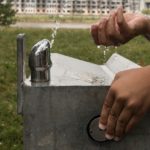The historic cold snap that brought Hoth-like conditions throughout vast swaths of the U.S. the other week was not the reason untold thousands of people couldn’t access adequate shelter and warmth necessary to survive sub-zero conditions. It simply highlighted the devastation caused when people can’t afford to stay warm.
Think about it: Most people in America don’t have to think about space very much. They can pretty much go wherever they want without incident.
Tens of millions of Americans have property. Or they have well maintained and comfortable rentals. They can come and go as they please. They can walk down the streets in relative safety, free from harassment. They can buy a coffee and hang out in Starbucks (well, they can if they aren’t Black). But for the most part, they can pay four bucks for some bean water and use the free WiFi for however long they want to. No one questions why they are in the mall or at a restaurant or on a train. They can pay the entrance fee to pretty much anywhere.
They look like they belong, so no one bothers them. Scott and Becky are warm and relaxed and drinking lattes that cost too much. And they might be inconvenienced by a missed flight or have to take a day or two off when a polar vortex rolls through – but, they’ll be just fine.
But what if you don’t have the funds for that overpriced cup of coffee? Or property? Or rent? What happens to you when polar vortex winds rip through your city with negative 20 degree or less wind chills? Where do you go?
Outside of parks and libraries, there are very few places a person can exist legally without paying rent, a fine or a fee. Less than 36 percent of households in the US make the $42,400 a year ($21.21 an hour) necessary to rent a 2 bedroom apartment in the United States. More than a quarter of American households fail to make the of $34,280 ($17.14 an hour) needed to rent a one bedroom. The federal minimum wage, at $7.25 an hour, produces an annual salary of $14,500 a year.
A 2007 Berkeley research study found that at a rate of 1.3 percent of total annual deaths, cold weather is responsible for just about the same loss of life in the U.S. than homicide. In fact, cold weather kills more than hot weather. When temperatures become severe, the lack of access to shelter becomes a life and death issue for people in poverty.
Just recently, in Milwaukee, WI a 38 year-old woman was found frozen to death in an apartment with a broken thermostat. In Buffalo, NY a homeless man was found frozen to death in a bus shelter. And in Lorain, Ohio 60 year-old woman died of hypothermia while seeking shelter in an abandoned house. In total, over 20 people were killed in the polar vortex that hit the Midwest and parts of the northeast this past week. Many of them were homeless … and these are the ones that we know about.
In the United States, there is far more than enough shelter for every person. The government alone holds 770,000 vacant buildings. According to the Federal Reserve, there are 17,231,000 vacant housing units in the US. Three out of four of these vacant units are investor properties and one in seven are bank owned. There are approximately 553,000 counted homeless people in the United States, 15% of whom are chronically homeless.
Homelessness isn’t cause by a lack of housing, it’s caused by a denial of housing.
For those priced out of housing entirely, shelters are seen as the go-to option for people trying to survive the winter. But shelters aren’t an option for the overwhelming majority of homeless individuals and families.
There are not enough shelter beds in any major city to meet the needs of every homeless adult and child residing there. Overcrowding is rampant and for those with social anxiety, Post Traumatic Stress Disorder (from war or poverty), or a fear of crowds – the canned-sardine conditions of the shelter system can be too much to overcome. Shelters are often also separated by gender – which can lead to the separation of families. Children are often not allowed in men’s shelters and teenage boys are often not allowed in women’s shelters. Parents are often forced to face separation from their children in exchange for shelter.
Pets – who can be as much of a close companion to poor people as they are to the middle-class pet owner – are generally not allowed in shelters, but there is often an abundance of bed bugs, lice, and roaches. Shelters often search and seize property and they tend to have lengthy and invasive intake processes. Sexual and physical assaults and theft are also common occurrences in shelters. If you drink or self medicate – like many sheltered Americans do – you can also be denied shelter and be left in the cold. And even if you can overcome all of these obstacles, shelters often keep strict hours that often conflict with the work schedules of lower-class laborers.
There are very few layers of support separating a homeless person from a casket during the winter in general – let alone during an arctic freeze. For those that can manage to find a rental, they aren’t guaranteed safety from the cold, either.
There are laws that require landlords to maintain a livable temperature in their rentals. As the Philadelphia-based Tenant Union Representative Network outlines, landlords must not only
“repair any material defects to a rental property which affect the health or safety of the occupants prior to renting and promptly during the lease” pursuant to the Philadelphia Property Maintenance Code, but they “must provide access to necessary heat, water, gas and electric services at all times during a lease” according to the Utility Service Tenants Rights Act and Philadelphia Code 9-1600. Yet, a lack of enforcement, the threat of retaliation from landlords (which happens even when tenants complain to agencies such as Licensing and Inspections) or lack of channels for reimbursement leaves tenants having to figure out how to heat their homes themselves.
Current policies, in even the most progressive of states, leave little recourse for tenants that are going without heat. For example, many states have heat requirements (that are often well below temperatures that the Average citizen finds comfortable), but there is little one can do if a landlord violates them. There is even less protection for the tenant if a landlord retaliates against a tenant for filing a complaint.
Broken heating systems, lack of hot water, drafty doors and windows all contribute to increased electricity bills and risks taken to heat dwellings with space heaters, ovens, stovetops, and other unsafe alternatives.
Space heaters are responsible for 43 percent of all home fires. In total, they cause 55,000 fires, 1,500 injuries and 450 deaths per year. In addition to burns and shocks, space heaters can cause power outages that can affect other tenants as well as complex-wide electricity grids. Personal heaters can and do often lead to carbon monoxide poisoning. The use of ovens and stovetops for added heat also leads to increased risks of fire, fire related injuries, and fatally polluted air supplies.
Compensating for the failure of a landlord to provide heat also leads to increases in electricity bills that bleeds over into other items in the family budget.
As reported by the Community Action Association of Pennsylvania, when landlords pass the cost of heating onto their low income tenants, they are forcing these individuals and families to choose whether they can “heat or eat.” They describe a situation where “[m]ost low-income families cut food and nutrition spending during the winter months in order to afford heating and energy costs. A 2015 study found that 25 million US households were skipping food and medicine needs in order to pay energy expenses. Parents will even go without a meal in order to ensure their children have enough to eat during these cold-weather budgetary shocks.”
As money is taken out of the budget for transportation and quality food, the ability to access nutritional meals also diminishes. And while starvation is extremely rare in the United States, malnutrition from low vitamin, high sugar diets is increasingly common. Anemia and similar nutritional deficiencies can also take a toll on work performance and energy levels.
In a bid to avoid costs, some families try to find creative, but often deadly alternatives. For example, a family of nine in Wheeling, IL was taken to the hospital with carbon monoxide poisoning after using a charcoal grill to heat their home. Others have turned to fires, electric blankets, and trying to stay warm by running their automobiles. All of these are hazardous and potentially life-ending practices forced by people choosing between freezing to death and risking their lives just to stay warm.
As the atmosphere continues to destabilize, more severe weather patterns will increase. Cold snaps like the one caused by the polar vortex this past week will become more frequent – as will the illness, injury, and death caused by inadequate shelter from the cold. These deaths and injuries can be prevented by increasing the amount of low and no income shelter opportunities for homeless people and by passing and enforcing strict heating and hot water laws that favor renters instead of landlords. The question is, can we mobilize to pass these policies before the next storm hits?



